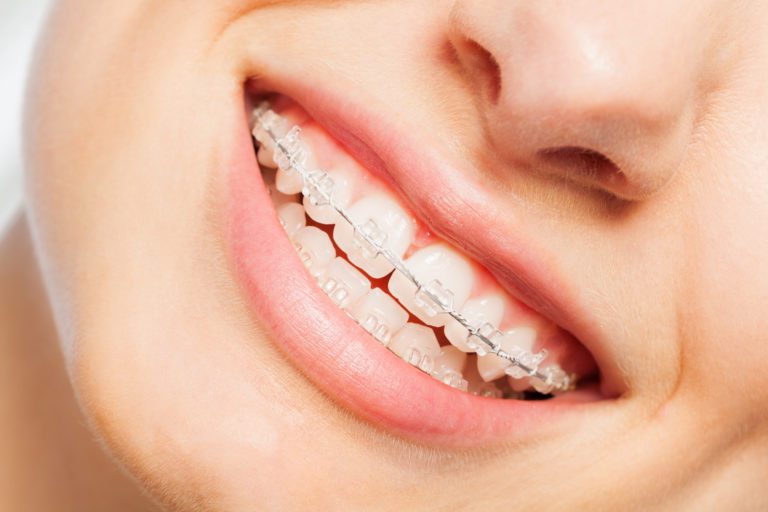A Great Option for Teenagers and Adults

Affordable Clear Ceramic Braces in NJ for a Radiant Smile
Clear ceramic braces offer a discreet yet effective treatment option when trying to achieve a flawless smile. These braces, crafted from transparent materials, are an ideal choice for individuals seeking orthodontic solutions that are less conspicuous than traditional metal braces. In the bustling world, clear ceramic braces have become a preferred choice for many.
Clear ceramic braces provide an excellent balance between visibility and functionality. They are not as inconspicuous as clear aligners but can address a broader range of orthodontic issues. Typically reserved for older teenagers and adults with cosmetic concerns, these braces blend seamlessly with your teeth.
However, it’s worth noting that clear ceramic braces demand meticulous oral hygiene. They are slightly larger and more fragile compared to their metal counterparts. As a result, they are commonly recommended for upper front teeth rather than lower teeth.
Clear Ceramic Braces vs. Traditional Braces
Clear ceramic braces function similarly to traditional braces in terms of teeth realignment. Each tooth receives a bracket, and an archwire guides them into their desired positions over time, exerting gentle and continuous force. Regular adjustment appointments, scheduled every few weeks, keep the treatment on track, typically spanning 18 to 30 months.
Understanding the Components of Clear Ceramic Braces
Ceramic braces have several key components, with brackets and archwires being central. The brackets used in these braces are smaller and shallower than those in the past, making them considerably less noticeable. However, their reduced size can render them slightly more fragile, necessitating caution when consuming sticky or hard foods that could potentially damage them.
Archwires, running through the brackets on each row of teeth, are meticulously selected by the orthodontist Deptford trusts based on your treatment plan. These wires provide consistent, gradual pressure, coaxing your teeth toward their correct positions. Colorful o-rings, also known as bands or ligatures, secure the archwires within the brackets.
The Role of Elastics
Elastics are a common addition to braces, especially if you have a malocclusion or a misaligned jaw. They exert pressure to align your jaws correctly. Following your orthodontist’s instructions regarding using rubber bands is essential for the success of your treatment. Wearing too many or too few rubber bands can hinder progress and extend treatment duration.
The Science Behind Teeth Alignment
Braces initiate a complex cellular process within your jaws when applying pressure to your teeth. Specialized cells called osteoclasts break down bone cells in front of the tooth, while osteoblasts generate new bone cells behind it. This remarkable process reshapes the bone, ensuring a snug fit for your teeth in their sockets.
This highlights the importance of seeking an experienced orthodontist for treatments involving dental crowding, crookedness, or bad bites. Their expertise ensures the most effective and safe approach to shifting teeth into their desired positions.
Maintaining Your Clear Ceramic Braces
Proper oral hygiene is crucial when wearing ceramic braces, just like regular braces. These braces can easily trap food particles between the brackets and wires, potentially leading to tooth decay and gum disease. Clear brackets and wires may also discolor when exposed to dark-pigmented foods or beverages such as coffee or wine. However, diligent oral care can prevent these issues.
FAQs
1. Are clear ceramic braces more comfortable than traditional metal braces?
Clear ceramic braces are designed for comfort; many patients find them more comfortable than traditional metal braces. The brackets are smoother and less likely to irritate the cheeks and lips. However, like all braces, there may be an initial adjustment period during which you may experience slight discomfort or soreness.
2. Are clear ceramic braces suitable for all orthodontic cases?
Clear ceramic braces are effective for many orthodontic issues but may not be suitable for highly complex cases. Your orthodontist will evaluate your needs during the initial consultation and recommend the most appropriate treatment option. Traditional metal braces or other orthodontic solutions may sometimes be recommended for more complicated issues.
3. Are clear ceramic braces more expensive than traditional metal braces?
Clear ceramic braces tend to be slightly more expensive than traditional metal braces due to the use of specialized materials. However, the cost difference can vary depending on the specific orthodontic treatment required and the orthodontist’s pricing structure.
Many orthodontic practices offer financing options and payment plans to make ceramic braces more affordable for patients. Discussing the cost and payment options with your orthodontist during your initial consultation is essential.
Clear Ceramic Braces | Affordable Braces in NJ
For those seeking an elegant and discreet orthodontic solution, our experienced orthodontists can guide you through the world of clear ceramic braces. Contact us today at (855) 776-9678 to schedule a smile consultation and discover if clear ceramic braces are the right choice. We specialize in providing affordable braces to help you achieve the smile you’ve always dreamed of.


